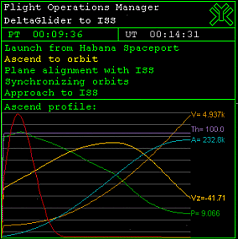
It does so by following the launch heading until the relative inclination reaches a minimum. The ascent then heads towards the velocity vector which leaves inclination and LAN unchanged.

The Ascent processor shows a profile of the six most important flight parameters during ascent: Pitch ("P" green), vertical velocity ("Vz" brown), velocity ("V" darkbrown), Altitude ("A" blue), Thruster level ("Th" magenta) and aerodynamic stress (unlabeled red).
<Step>
<Label>Ascend to orbit</Label>
<Processor type="Profile">
<Var name="H"> 2k 60k 100k 110k </Var>
<Var name="Pitch"> 50 50 40 18 </Var>
<Var name="Thrust"> 100 100 100 100 </Var>
<Var name="AlignWith"> Mir </Var>
<Var name="LockVz"> yes </Var>
<Var name="MaxG"> 3.0 </Var>
<Var name="CompleteAt"> ApD = 6.77M </Var>
</Processor>
</Step>
The Ascent profile processor currently only handles altitude-based profiles (no
time- or rule-based profiles in this version). An altitude-based profile
maps a current altitude into target values for pitch and thruster level.
It may take some experiments (and thus experience) to design your own profile. I recommend
you fly the ship by hand to orbit and write down your pitch and thruster levels at
different altitudes and use that to create a new Ascent profile.AlignWith should reference the vessel (resp. space station) you want to meet in orbit. This allows the Ascent processor to minimize relative inclination between our own and the reference orbit.
MaxG defines the maximal acceleration allowed during ascent (in G). This setting overrides any thruster level defined if necessary.
LockVz allows to override any defined pitch value at the end of the ascent. Activated when the vertical velocity becomes zero; while active the pitch is calculated to keep the vertical velocity close to zero. This option makes orbit injection (and profile definition) much easier and simpler.
CompleteAt defines the condition when the Ascent to orbit is considered complete.